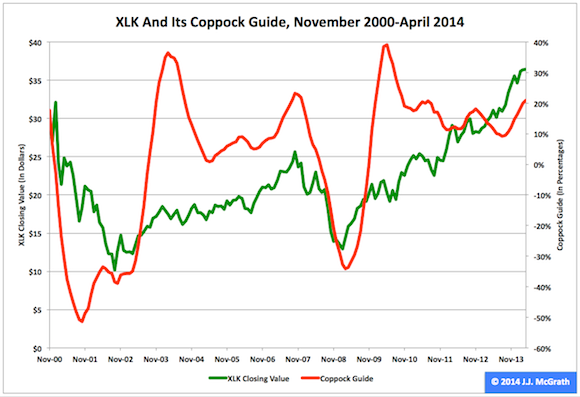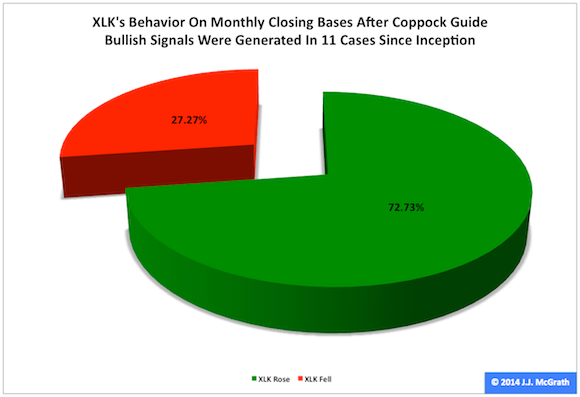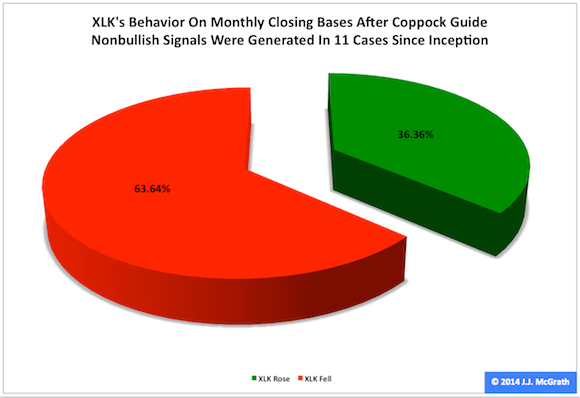The Technology Select Sector SPDR exchange-traded fund (XLK) ranked No. 6 by return among
the ETFs that divide the S&P 500 into nine pieces during the first third of
this year, as its adjusted closing share price ascended to $36.45 from $35.59, a
climb of 86 cents, or 2.42 percent.
Over this period, XLK’s return was about one-sixth that of
the Utilities SPDR ETF (XLU)
and about the same as that of the SPDR S&P 500 ETF (SPY), as described in “XLU Coppock Guide: Bullish as of May Day 2014.”
(XLU returned 14.74 percent, and SPY returned 2.41 percent.)
XLK is the sixth of 13 ETFs to be featured in a J.J.’s Risky
Business blog series this month. Basically, I will be looking at each
ETF with both eyes fixed on its Coppock guide, as was the case in “SPY Coppock Guide: Away From Bullishness, Toward
Nonbullishness as of March 31, 2014.” The Coppock guide, aka either the
Coppock curve or the Coppock indicator, is a long-term indicator of price
movements in major stock-market indexes calculated on the basis of monthly
data.
Figure 1: XLK And Its
Coppock Guide, The Complete History
Note: The XLK
closing-value scale is on the left, and the Coppock guide scale is on the
right.
Source: This J.J.’s
Risky Business chart is based on
proprietary analyses of Yahoo Finance adjusted monthly share-price data and those data themselves.
Edwin S. Coppock developed his long-term guide not to flash both
bullish and bearish signals but to generate only bullish signals. However, I
employ it to produce either bullish or nonbullish signals. It is extremely
important to keep in mind that a nonbullish signal is not equivalent to a bearish signal in the context of the guide.
I anticipate XLK may rise after a bullish signal and expect
it might do anything following a nonbullish signal (i.e., trade higher, lower
or sideways).
Figure 2: XLK’s
Behavior Subsequent To Initial Bullish Signals
Source: This J.J.’s
Risky Business chart is based on
proprietary analyses of Yahoo Finance adjusted monthly share-price data.
The XLK Coppock guide’s initial bullish signals collectively
have done a good job in forecasting the future upward movements of the ETF on
monthly closing bases. In 11 cases since November 2000, these signals have been
correct on eight occasions, or 72.73 percent of the time, and incorrect on three
occasions, or 27.27 percent of the time. All the errant signals flashed in
proximity to SPY’s 2011 bear market, when that ETF dipped intraday to $107.43
on Oct. 4 from $137.18 on May 2, a drop of $29.75, or 21.69 percent.
The XLK Coppock guide’s latest initial bullish signal was
generated last August, when the ETF’s closing share price was $30.96.
Accounting for the one-month lag in the confirmation of any signal, I note XLK’s
closing share price grew to $36.45 in April from $31.75 in September, which clearly
constitutes bullish action by any standard.
However, I also point out the XLK Coppock guide’s rate of
increase has significantly slowed during the past three months: It was 0.92
percent in April, 1.50 percent in March and 2.08 percent in February.
Therefore, I would be completely unsurprised should we see an initial
nonbullish signal produced by the middle of this year (i.e., July 1).
Figure 3: XLK’s
Behavior Subsequent To Initial Nonbullish Signals
Source: This J.J.’s
Risky Business chart is based on
proprietary analyses of Yahoo Finance adjusted monthly share-price data.
The XLK Coppock guide’s initial nonbullish signals
collectively have compiled an interesting track record when evaluated on
monthly closing bases. Keeping in mind that a nonbullish signal is not equivalent to a bearish signal in
the context of the Coppock guide, the flashing of 11 initial nonbullish signals
since November 2000 has been followed by the ETF’s share price falling on seven
occasions, or 63.64 percent of the time, and rising on four occasions, or 36.36
percent of the time.
The analyses associated with “NYSE
Margin Debt Falls In March For First Time In 9 Months: Risk Rank At No. 55”
and “S&P 500 And U.S. Economic Index Show
Early Signs Of A Return To Normalcy” both indicate fundamental reasons why
the equity market and XLK may be either at or close to long-term peaks.
And the analyses associated with “Coppock Guide: The Blog
Series” all suggest a technical reason for the same outlook vis-à-vis the stock
market and XLK.
Coppock Guide: The
Blog Series
Related Reading
Author’s Note: This is
the sixth blog post in a May series centered on the Coppock guides of 13
important ETFs, among them all nine Select Sector SPDRs. The first was
cross-posted at both J.J.’s Risky Business and
J.J. McGrath’s Instablog on Seeking Alpha, but the rest of the series will be posted here. You can follow me
(and the series) @JJMcGrath3000 on Twitter, at JJMcGrath on StockTwits and via myself on Google+.
Disclaimer: The opinions
expressed herein by the author do not constitute an investment recommendation,
and they are unsuitable for employment in the making of investment decisions.
The opinions expressed herein address only certain aspects of potential
investment in any securities and cannot substitute for comprehensive investment
analysis. The opinions expressed herein are based on an incomplete set of
information, illustrative in nature, and limited in scope. In addition, the
opinions expressed herein reflect the author’s best judgment as of the date of
publication, and they are subject to change without notice.



No comments:
Post a Comment